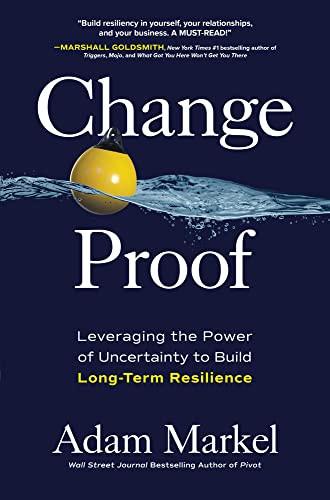instructor Hood's Key Ideas from Change Proof: Leveraging the Power of Uncertainty to Build Long-term Resilience
by Adam Markel
Ideas, facts & insights covering these topics:
16 ideas
·786 reads
3
Explore the World's Best Ideas
Join today and uncover 100+ curated journeys from 50+ topics. Unlock access to our mobile app with extensive features.
Change Proof
- Anticipate constant change in your life.
- Become resilient by adhering to three principles: “Pause, Ask, Choose.”
- Develop resilience when you don’t need it, so you have it when you do.
- Heed the signs of chronic stress and its impact on your physical well-being.
- Appreciate what you can control with mental resilience.
- Bolster your emotional resilience to prevent negativity from weighing you down.
- Practice spiritual resilience by appreciating the world around you and connecting with others.
- Resilient organizations thrive in the face of uncertainty.
12
86 reads
Anticipate constant change in your life
Constant change has become part of people’s lives. Uncertainty makes individuals feel anxious. In the past, often you could attribute stress and anxiety to major one-off events – a new job, a failed relationship or the onset of a health issue. You cannot plan ahead for these micro pivots, nor can you avoid them. Cultivate a mind-set that flows with the uncertainty life offers and find opportunity in the disruption. To do this, you must develop resilience.
“Uncertainty has become the new certainty.”
13
63 reads
Many people believe that being resilient means fighting off stress and bouncing back to how their lives were before the disruption. Yet resilience takes on new meaning in the face of constant change and uncertainty – even with positive change, since that, too, causes stress. Instead of resisting change and trying to reduce uncertainty, accept change as a constant to gain a renewed perspective on stress and to become change-proof.
12
60 reads
Become resilient by adhering to three principles: “Pause, Ask, Choose.”
- Pause – When you stop fighting change, you gain the space you need to observe and learn. Acknowledge the energy you expend when fighting change. Like rebooting a computer, take a minute to reset.
- Ask – Reframe your situation, and reset your perspective. Ask yourself how you want to ride the change. Find your purpose.
- Choose – Take what you’ve learned and recover. In the midst of daily uncertainty, control your reaction to change and choose your next step. Resiliency doesn’t return you to your former self, but by choosing to move forward, you learn the essence of being change-proof.
15
63 reads
Resilience does not ward off change, nor does it shield you from the pain change can cause. Instead, when you pause, ask and choose, you find your way through the stress change brings.
“Resilient people aren’t thermometers, which can only respond to the changing variables of temperature; rather, they’re thermostats, setting the temperature around them.”
13
59 reads
Develop resilience when you don’t need it, so you have it when you do
Most people seek balance between their professional and personal lives. Yet, like children on a playground seesaw, when the pairs balance, they stop moving. When they move up and down, they create harmony. The ocean teaches harmony in its constant movement as tides come and go, and shows you the fragility of the status quo. Leaders must create such harmony within their organizations to flow in the midst of the constant motion of business.
11
52 reads
Like harmony, resilience is dynamic. It ebbs and flows as you weave in and out of uncertainty. When you develop resilience, you create harmony among the “four realms” of the human character: body, mind emotions and spirit. You view change and uncertainty through a different lens; you no longer see stress as bad, but as something to use to your advantage, because you learn to pause, ask and choose.
“This is how we perform resilience. We pause with our body. We ask with our minds and hearts. We choose with our spirit.”
11
50 reads
Heed the signs of chronic stress and its impact on your physical well-being
Chronic stress has a negative impact on performance as well as physical well-being. Sled dog owners, for example, must pause their dogs when running races before they tire to maintain top performance throughout the race; dogs will not pause on their own. Farmers must allow the soil to pause and rebuild its nutrients to maintain high yields over the long term. Humans, too, must pause to rest and recover. Yet many people believe that they constantly need to fight, to not give in, but this approach creates diminishing returns.
11
40 reads
You lose motivation, suffer from fatigue and withdraw from your circle of support. You no longer enjoy your passions, your activities, your accomplishments; these activities shift in your mind from aspirations to obligations.
“We’ve got to take the lesson from our sled dogs, who may not like it, but they’ve got to rest at the beginning, so they’ve got something left later.”
11
41 reads
Appreciate what you can control with mental resilience
As you accept change as the new normal, you need not accept the worry that follows. You have a choice. Those who successfully leverage uncertainty control, not the inevitable change that comes their way, but how they respond to it. With mental resilience, you think your way through unexpected challenges and tasks. Mental resilience does not suggest you avoid thinking.
“Mental resilience isn’t a life free from the twin wolves of worry and anxiety. It’s about harnessing our energy in creative ways.”
12
37 reads
To develop mental resilience, examine your thoughts and challenge your negative or irrational beliefs. Turn your mind-set around and create opportunities that change offers. Challenge yourself to look for positivity and optimistic outcomes in the face of disruption. Develop this habit to channel stress and build mental resilience.
11
37 reads
Bolster your emotional resilience and prevent negativity from weighing you down
When your emotions spiral downward, try the “3-4 Method,” during which you use your breathing to pause, ask, choose:
Inhale – Do you like feeling this way?
Hold – Do you want to let it go?
Hold – Are you willing to let it go?
Exhale – When will you let it go?
14
45 reads
Practice spiritual resilience by appreciating the world around you and connecting with others
Your spirit grounds you and carries you through your successes and failures. To grow your spiritual resilience, pause, reflect and connect with others. For example, those who show resilience in the wake of a traumatic event share characteristics that help them survive, and in many cases, thrive. These people:
- Appreciate life and see its possibilities.
- Improve relationships with others and connect with them spiritually.
- Demonstrate personal strength.
12
38 reads
When uncertainty hits, many people naturally pull inward. But to find your spiritual resilience, you must connect with others. Focus on what you have, not on what you don’t have; focus on a future endeavor; and believe things will work out. These practices, when repeated, create a habit of spiritual resilience that pulls you forward and gives you inspiration.
“The mind-set of gratitude puts us exactly in line with resilience because we take the world as it comes to us, as it is, instead trying to make it correspond to every “must” that churns through our heads and hearts.”
12
37 reads
Resilient organizations thrive in the face of uncertainty
Develop a culture of resilience in your organization to spur creativity and activate the four realms. Pause to reframe your circumstances; ask questions to reset perspective, and choose to recover and move forward. Use your imagination to envision the future you want for your team and your organization.
“You can’t stop the rain, but you can make sure you’ve got the best and the biggest umbrella.”
12
36 reads
Strategic foresight helps you adopt creative imagination and thrive in turbulent times. Set goals – the “what” in your future – and systems – the “how”– to get there. The systems, or habits, you establish provide the creative license your organization needs to make decisions toward achieving goals and to imagine future success.
11
42 reads
IDEAS CURATED BY
CURATOR'S NOTE
Leveraging the Power of Uncertainty to Build Long-term Resilience
“
Different Perspectives Curated by Others from Change Proof: Leveraging the Power of Uncertainty to Build Long-term Resilience
Curious about different takes? Check out our book page to explore multiple unique summaries written by Deepstash curators:
Discover Key Ideas from Books on Similar Topics
8 ideas
You Are a Badass®
Jen Sincero
8 ideas
Amplify Your Influence
Rene Rodriguez
10 ideas
HBR's 10 Must Reads on Strategy
Harvard Business Review, Michael E. Porter
Read & Learn
20x Faster
without
deepstash
with
deepstash
with
deepstash
Personalized microlearning
—
100+ Learning Journeys
—
Access to 200,000+ ideas
—
Access to the mobile app
—
Unlimited idea saving
—
—
Unlimited history
—
—
Unlimited listening to ideas
—
—
Downloading & offline access
—
—
Supercharge your mind with one idea per day
Enter your email and spend 1 minute every day to learn something new.
I agree to receive email updates

